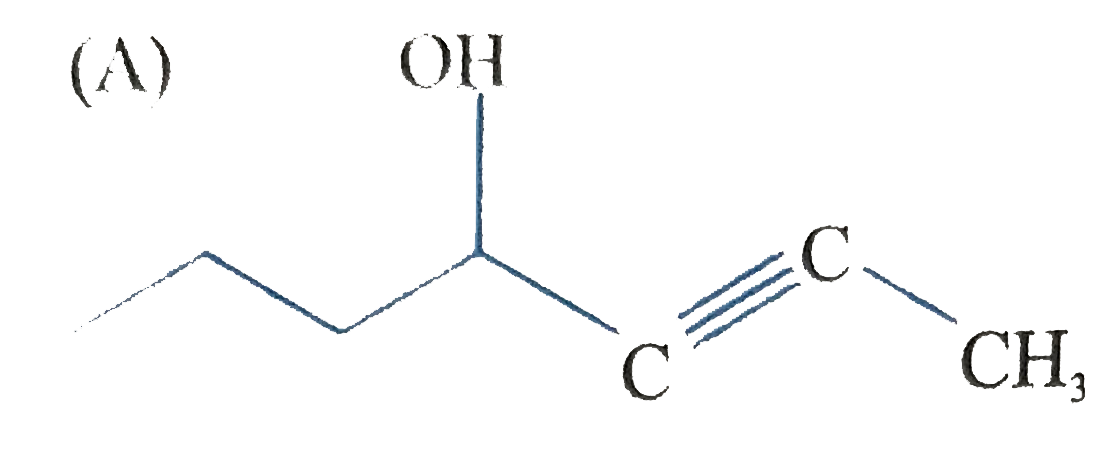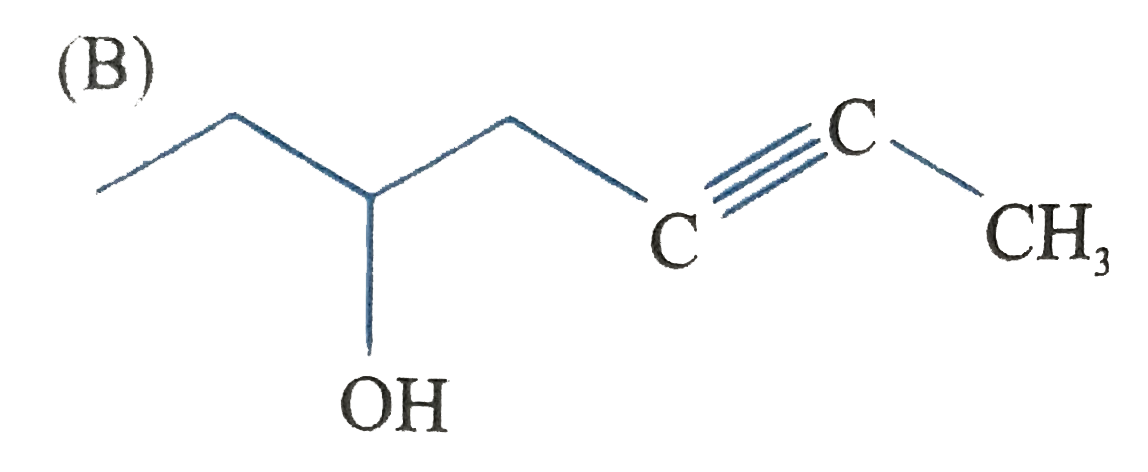What is the type of hybridisation of carbon atoms marked with star.
(a)∗CH2=CH−∗O∣∣C−O−H (b)CH3−∗CH2−OH (c)CH3−CH2−O∣∣C∗−H
(d)∗CH3−CH=CH−CH3 (e)CH3−∗C≡CH
To determine the type of hybridization of the carbon atoms marked with a star in the given molecules, we will analyze each structure step by step.
Step 1: Analyze the first structure (a)CH2=CH−O=C−O−H
- The carbon marked with a star is part of the double bond (C=C).
- In a double bond, one sigma bond and one pi bond are formed.
- Since this carbon is involved in one double bond and has one single bond (to the other carbon), it is forming three sigma bonds in total (two with hydrogens and one with the adjacent carbon).
- Therefore, the hybridization of this carbon is sp².
Step 2: Analyze the second structure (b)CH3−CH2−OH
- The carbon marked with a star is connected to two other carbons and two hydrogens.
- It forms four single bonds (one with the adjacent carbon and two with hydrogens).
- Therefore, the hybridization of this carbon is sp³.
Step 3: Analyze the third structure (c)CH3−CH2=O−C−H
- The carbon marked with a star is involved in a double bond with oxygen (C=O) and has one single bond to hydrogen.
- It forms three sigma bonds (one with the adjacent carbon and two with oxygen).
- Therefore, the hybridization of this carbon is sp².
Step 4: Analyze the fourth structure (d)CH3−CH=CH−CH3
- The carbon marked with a star is part of a double bond (C=C).
- It forms three sigma bonds (two with adjacent carbons and one with hydrogen).
- Therefore, the hybridization of this carbon is sp².
Step 5: Analyze the fifth structure (e)CH3−C≡CH
- The carbon marked with a star is involved in a triple bond (C≡C).
- It forms one sigma bond and two pi bonds with the adjacent carbon.
- Therefore, the hybridization of this carbon is sp.
Summary of Hybridizations:
- (a) sp²
- (b) sp³
- (c) sp²
- (d) sp²
- (e) sp
- The carbon marked with a star is part of the double bond (C=C).
- In a double bond, one sigma bond and one pi bond are formed.
- Since this carbon is involved in one double bond and has one single bond (to the other carbon), it is forming three sigma bonds in total (two with hydrogens and one with the adjacent carbon).
- Therefore, the hybridization of this carbon is sp².
- The carbon marked with a star is connected to two other carbons and two hydrogens.
- It forms four single bonds (one with the adjacent carbon and two with hydrogens).
- Therefore, the hybridization of this carbon is sp³.
- The carbon marked with a star is involved in a double bond with oxygen (C=O) and has one single bond to hydrogen.
- It forms three sigma bonds (one with the adjacent carbon and two with oxygen).
- Therefore, the hybridization of this carbon is sp².
- The carbon marked with a star is part of a double bond (C=C).
- It forms three sigma bonds (two with adjacent carbons and one with hydrogen).
- Therefore, the hybridization of this carbon is sp².
- The carbon marked with a star is involved in a triple bond (C≡C).
- It forms one sigma bond and two pi bonds with the adjacent carbon.
- Therefore, the hybridization of this carbon is sp.
- (a) sp²
- (b) sp³
- (c) sp²
- (d) sp²
- (e) sp
Topper's Solved these Questions
- CHEMICAL BONDING AND MOLECULAR STRUCTURE BOOK - DINESH PUBLICATIONCHAPTER - CHEMICAL BONDING AND MOLECULAR STRUCTURE EXERCISE - ADDITIONAL IMPORTANT QUASTIONS
41 Videos
- CHEMICAL BONDING AND MOLECULAR STRUCTURE BOOK - DINESH PUBLICATIONCHAPTER - CHEMICAL BONDING AND MOLECULAR STRUCTURE EXERCISE - H.O.T.S. CONCEPTUAL QUESTIONS
11 Videos
- CHEMICAL BONDING AND MOLECULAR STRUCTURE BOOK - DINESH PUBLICATIONCHAPTER - CHEMICAL BONDING AND MOLECULAR STRUCTURE EXERCISE - COMPREHENSION
4 Videos
- CARBOXYLIC ACIDS AND THEIR DERIVATIVESBOOK - DINESH PUBLICATIONCHAPTER - CARBOXYLIC ACIDS AND THEIR DERIVATIVESEXERCISE - Unit test
20 Videos
- CLASSIFICATION OF ELEMENTS AND PERIODICITY IN PROPERTIESBOOK - DINESH PUBLICATIONCHAPTER - CLASSIFICATION OF ELEMENTS AND PERIODICITY IN PROPERTIESEXERCISE - All Questions
310 Videos
Similar Questions
Discuss the concept of hybridisation. What are its different types in a carbon atom?
b) What is the type of hybridisation of carbon atoms marked with star?
(i) ∗CH2=CH−O∗∣∣C−O−H (ii) CH3−∗CH2−OH
(iii) CH3−CH2−O∣∣C∗−H (iv) ∗CH3−CH=CH−CH3
(v) CH3−∗C≡CH
View SolutionEvaluate the type of hybridisaton of carbon atoms marked with star.
(a) ∗CH2=CH∗−O∣∣C−O−H
(b) CH3−∗CH2−OH
(c) CH3−CH2−O∣∣C∗−H
(d) ∗CH3−CH=CH−CH3
(e) CH3−∗C≡CH
Number of carbon atoms of hybridisation :
Type-I = x
Type-II = y
Type-III = z
If x gt y gt z, then find xy - z
View Solution
Knowledge Check
CH3CH2CH2−O∣∣C−H+CH3−C≡CHNa,NH3(l)−−−−−−−→
A B
B C
C D
D
The IUPAC name for
CH3−O∣∣C−CH2−CH2−O∣∣C−OH is :A1-Hydroxypentane-1, 4-dioneB1, 4-DioxopentanolC1-Carboxybutan-3-oneD4-Oxopentanoic acidCH3−O∣∣C−CH3 and CH3−O∣∣C−H is differentiated by:
AiodoformBNaHSO3C2,4-DNPDnon of these
Evaluate the type of hybridization of carbon atoms marked with star.
(A) ∗CH2=CH−∗C∣∣O−O−H
(B) CH3−∗CH2−OH
(C) CH3−CH2−∗C∣∣O−H
(D) ∗CH3−CH=CH−CH3
(E) CH3−∗C≡CH
Number of carbon atoms of hybridization:
Type-I =x ; Type-II=y; Type-III=z
If x>y>z ; then find {y2−x+z6}
View SolutionCH3−CH∣CH3−CH=CH−CH2−O∣∣C−OH
View SolutionCH3−O∣∣C−H and CH3−O∣∣C−CH3 is differentiated by :
View SolutionCH3−OH∣CH−O∣∣C−CH2−CH3 will respond to
View SolutionThe IUPAC name for CH3−O∣∣C−CH2−CH2−O∣∣C−OH is ______.
View Solution
